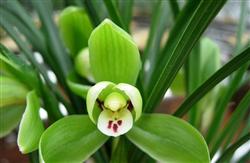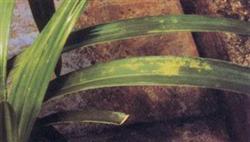Orchid virus diseases General characteristics
Orchid virus disease is the number one killer affecting orchid cultivation, orchid enthusiasts all talk about the virus and change color. Orchid virus disease is ubiquitous again. It infects not only cultivated orchid varieties, but also wild orchids growing under natural conditions. Once the orchid is infected by the virus, its appreciation and cultivation value will decline rapidly. Therefore, it is necessary to have a full understanding of orchid virus disease in China. Virus (Virus) is a kind of idiopathic parasite, much smaller than bacteria, its size is about 10-30 μ m, which can not be seen under ordinary light microscope. The virus has no structure of cell wall and nucleus, and is fibrous, rod-shaped and so on. In general, some viruses can be extracted into crystals from the plant. Under the electron microscope, there are very neatly and tightly arranged virus particles in the virus crystals. The virus consists of nucleic acid and protein. Most of the nucleic acids of viruses parasitic on Chinese orchid plants are ribonucleic acid (RNA). The nucleic acid of the virus is coated in the shell of a layer of protein. When the virus infects the cell, only the nucleic acid enters the plant cell, while the shell of the protein is left in vitro. Therefore, it is only the nuclear protein part that has infectivity, and its pathogenicity is mainly determined by its nucleic acid part. Some viruses can have two different forms. Particles with different morphology may have different genetic division of labor. Only when the particles of different forms enter the host together, can all the infectivity, pathogenicity and other genetic characteristics of the virus be shown. The virus of orchid has a high ability of proliferation. The mode of proliferation is different from that of cellular organisms. Instead of absorbing nutrients in parasitic cells to form a large virus and then dividing into a small virus, it uses RNA to replicate. Under the control of viral nucleic acid, the host cell synthesizes the same substance as the nucleoprotein of the virus to form a new virus. The harmfulness of the virus also lies in changing the metabolic pathway of parasitic cells and destroying normal physiological procedures. In orchids, the virus seems to destroy the chloroplasts in the cells, resulting in chlorosis of the cells, causing disorders in the assimilation of nutrients in the cells, and yellowing or necrosis of leaf tissues. It is necessary to further study whether the virus particles directly act on the cells or the toxins released by the virus.
- Prev

Control of common diseases in orchids
1. Phytophthora disease: it occurs all the year round, but in the plum rain season, the disease is the most serious when watering is too wet or poor ventilation, especially the seedlings just out of the bottle are the most vulnerable. The infected site produced brown disease spot, which expanded rapidly in high temperature and humidity, and finally showed black brown spot, and deciduous stem rot until the plant died. Prevention and treatment methods:.
- Next

Infection cycle of orchid virus disease
Viruses are parasites in living cells. It does not have the ability to destroy plant cell walls, nor can it carry out saprophytic life on dead cells and tissues as parasitic transition like other parasitic parasites. Therefore, when the virus invades the orchid strain, a slight wound must be required. This kind of wound can cause fineness.
Related
- Fuxing push coffee new agricultural production and marketing class: lack of small-scale processing plants
- Jujube rice field leisure farm deep ploughing Yilan for five years to create a space for organic food and play
- Nongyu Farm-A trial of organic papaya for brave women with advanced technology
- Four points for attention in the prevention and control of diseases and insect pests of edible fungi
- How to add nutrient solution to Edible Fungi
- Is there any good way to control edible fungus mites?
- Open Inoculation Technology of Edible Fungi
- Is there any clever way to use fertilizer for edible fungus in winter?
- What agents are used to kill the pathogens of edible fungi in the mushroom shed?
- Rapid drying of Edible Fungi

